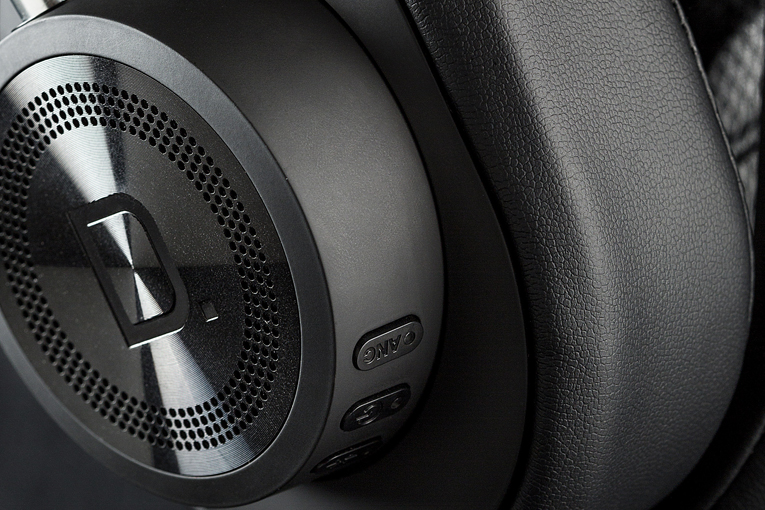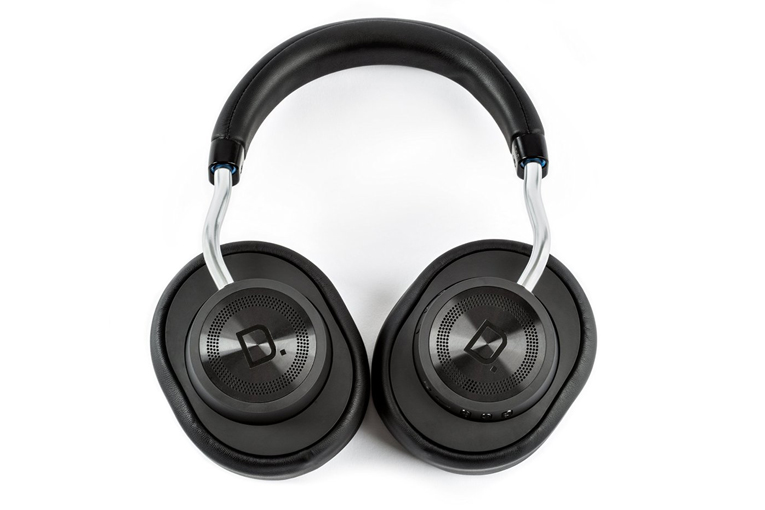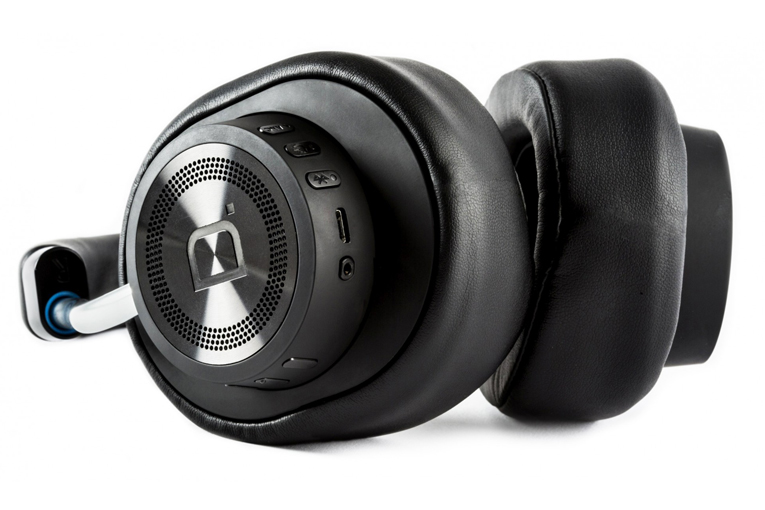Originally published on SoundStage! Xperience
Definitive Technology Symphony 1 measurements can be found by clicking this link.
A few years ago, I’d have been tantalized by the fact that Definitive Technology is getting into the headphone business -- but these days, what mainstream speaker company isn’t in the head-fi biz? Still, I have to admit that I’m impressed that DefTech has jumped in in such a big way. Most speaker companies begin with simple, passive headphones; but DefTech’s Symphony 1s ($399 USD) include noise canceling, Bluetooth, and a direct digital input.

Noise canceling is notoriously tough to get right, for two reasons. First, many headphones sound very different with NC on from how they sound with NC off; getting one of those modes tuned right isn’t too hard, but getting both right apparently is. Second, I’m told by many sources that Bose has all the patents on noise canceling locked down, a contention supported by the fact that almost no headphones can even approach the amazing noise-canceling prowess of Bose’s QC25s.
The only viable way to compete with the QC25s (other than by cutting price) is by upping the sound quality, something PSB has done with their M4U 2 noise-canceling ’phones. The Symphony 1s attempt to follow that path of superior sound and up the ante with Bluetooth, a feature PSB has yet to offer.
The Symphony 1s also offer a feature I can’t remember seeing in any other headphone model: a direct digital input via USB. Using this connection, you can directly access the Symphony 1s’ internal digital-to-analog converter (DAC). When you’re listening to music sourced from a computer, this USB digital connection lets you bypass the computer’s internal DAC as well as the headphones’ analog-to-digital converter (ADC). This also avoids the data compression and decompression introduced by Bluetooth, and technically should deliver the best possible sound from these headphones.
What this also means is that all of the signals that pass through the Symphony 1s’ analog input are converted to digital, run through a digital signal processing (DSP) chip, then reconverted to analog. Some audiophiles recoil at any mention of digital audio, but in the case of headphones, their fear is misplaced. DSP is becoming common in active headphones such as the Symphony 1s because it holds the potential for colossal improvements in sound quality. It’s easier, more affordable, and more effective to fine-tune headphones’ response with DSP than by physically “tuning” ’phones with alterations in driver materials and design, or changes of damping materials. And using DSP with internal amplification eliminates the uncertainties of how the reactance of passive headphones will interact with the (usually unknown) output impedance of the headphone amp.
The look of the Symphony 1s is understated, with a clear vibe of hi-tech exec. In pursuit of a reliable acoustical seal against your head, the earpieces can swivel in every direction. The drivers are angled slightly back, as in Sennheiser’s flagship headphones, the HD 800s, a design intended to increase the spaciousness of the sound and better simulate the experience of listening to conventional speakers.
Controls for On/Off, Active Noise Cancellation (ANC), Bluetooth, Volume Up/Down, and Pause/Play/Skip are arrayed on the right earpiece. The volume controls work only in Bluetooth mode; all the rest work with a wired connection (Android, iOS). A built-in microphone lets you take phone calls, and the headband and earcups are nicely padded. It’s obvious that DefTech has put a lot of thought and work into this design.

The Symphony 1s offer three listening modes: passive (power off), active (power on but NC off), and NC. In Bluetooth mode, NC can be turned on or off.
In the box
The Symphony 1s come with a carrying case, and a faux-silk fabric bag for when you don’t want to use the case. A 1.2’ cable is included for times when you can’t or don’t want to use Bluetooth, as is a USB-to-Micro-USB charging cable.
Use
When it comes to ergonomics and daily use, the Symphony 1s have one especially welcome plus, one significant minus, and one little flaw.
The welcome plus is the comfort. The 1s’ earpads are relatively firm, so they don’t have that lush comfort offered by, say, Bose’s QC25 headphones ($299.95). However, the DefTechs’ long-term comfort ranks among the best I’ve encountered, and may be the best. I recently endured a round trip to London that landed me back at LAX only 53 hours after I’d left. Completely strung out, I fell asleep on the return flight wearing the Symphony 1s while watching some TV show, woke up six hours later, and immediately became engrossed in the latest issue of The New Yorker. I didn’t realize I still had the headphones on until an announcement from the captain came through about half an hour later. Normally, I’m thrilled if I can wear headphones for two hours on a flight without experiencing discomfort -- and here I’d worn the Symphony 1s for seven hours straight. I found the DefTechs considerably more comfortable than the QC25s -- which are legendary for their comfort -- and way more comfortable than the PSB M4U 2s ($399).
One last point about comfort: For me, the Symphony 1s’ don’t have as much “eardrum suck” as the QC25s -- a pressure on the eardrum caused by the noise-canceling circuitry. However, there’s a price to be paid for that, as you’ll read in the next section.

The significant minus is the DefTechs’ size. When I showed the Symphony 1s’ case to fellow journalist and ultra-frequent-flier Geoff Morrison, he just shook his head: “No way.” The case measures 9.5” by 8.5” by 3.2” (240mm by 220mm by 80mm) -- about three times the volume of the QC25s’ case. But the M4U 2s’ case, too, is pretty chunky -- I carry a laptop bag on flights, and the DefTech and PSB cases do not fit into it. The Symphony 1s’ earpieces do fold flat to a height of about 2.3” (60mm), and folded up in their cloth bag, they’ll fit in a laptop case. Still, in my opinion, the Symphony 1s are too bulky for those who like to travel light.
The nit I must pick: The Symphony 1s’ controls, like those on so many audio products these days, are black buttons labeled in gloss black -- easy to read in good light, impossible otherwise. Here, function is clearly following form.
Sound
I used the Symphony 1s with three different source devices: my iPod Touch, my Samsung Galaxy S6 smartphone, and a Boeing 787 Dreamliner. Because the Symphony 1s have their own internal amplifier, there’s no point in using them with a separate headphone amp -- and, of course, noise-canceling headphones are, almost by definition, products intended for travel, not serious listening at home. I used the Symphony 1s in Bluetooth and wired modes, depending on the circumstances.
Jazz tenor saxophonist Stanley Turrentine’s Blue Hour (256kbps MP3, Music Matters) showed me right off that the Symphony 1s sounded better than the Bose QC25s. I heard much more detail and sense of space, a flatter and more neutral overall frequency response, and bass that was tighter than the QC25s’, without the mild exaggeration of low-end level I hear from the Boses. I also used Blue Hour to compare the Symphony 1s with PSB’s M4U 2s, which I briefly borrowed from fellow reviewer Lauren Dragan. With this album, the M4U 2s had all the positive attributes of the Symphony 1s, plus a little extra: the sound of Turrentine’s tenor was even more open and detailed, yet also more focused, with a bit more midrange energy that slightly smoothed the sound. Still, the Symphony 1s were not at all embarrassed by the comparison; I expect that some enthusiasts might, in this instance, have preferred its sound.

In the previous comparison, I’d turned on the noise canceling for all three headphone models. Curious what effect NC would have on the Symphony 1s’ sound, I played “Chartreuse,” from ZZ Top’s La Futura (256kbps MP3, American Recordings), and switched among the DefTechs’ three listening modes. Passive (power off) sounded just OK; the sound was much lower in level and somewhat dull, and Billy Gibbons’s voice had a slight “cupped hands” coloration and sounded coarser than it usually does (and it’s pretty coarse to begin with). I turn the power on and the sound was transformed. Voices were more natural and open, and the treble came out more. But the sound was also thinner -- the fat bottom end of Dusty Hill’s bass guitar was lost. I thought the Symphony 1s sounded best by far with NC on. The tonal balance was then just a bit bassy (which most listeners, even many enthusiasts, tend to like), and voices had the same vivid, clear quality they had with NC off.
With “Solar,” from the Bill Evans Trio’s The Complete Village Vanguard Recordings, 1961 (256kbps MP3, Riverside), the Symphony 1s struck the best tonal balance of the three headphones I listened to in this comparison. The detail in Scott LaFaro’s double bass impressed me, and the tone and spaciousness of Evans’s piano were pretty much right on. In comparison, the Bose QC25s sounded softer in the treble, the PSB M4U 2s a little bass-shy.
For all the same reasons, the Symphony 1s sounded great with “Viva Las Vegas,” from Holly Cole’s Night (256kbps MP3, Rumpus Room/Tradition & Moderne). Because the DefTechs’ bass was prominent but tight and well controlled, it allowed the breath and presence of Cole’s voice to come through beautifully, along with the details in the percussion and piano.

Through the Symphony 1s, “The Best Is Yet to Come,” from Frank Sinatra and Count Basie’s It Might As Well Be Swing (256kbps MP3, Reprise), had a notably left/center/right sound: Sinatra’s voice very solidly at dead center, Basie’s band split hard right and hard left. Sinatra had only just slightly more edge through the Symphony 1s than through the M4U 2s -- I guessed +2dB at 2.5kHz -- and it helped his voice stand out from the band, even if it did make the horns a bit too bright for my taste. The bass grooved hard in “Wives and Lovers,” from the same album; I suppose some might say a double bass shouldn’t be so prominent in a big-band mix, but I thought it sounded great.
To get a handle on how the direct USB connection might affect the Symphony 1s’ sound, I connected them via USB to the Toshiba laptop computer on which I store my music, and compared that sound with the sound of a standard analog wired connection via the laptop’s headphone output (which is provided by an internal Realtek audio chip, the type most commonly used in PC laptops). I matched the output levels to within 0.5dB using my G.R.A.S. Model 43AG ear/cheek simulator and a test signal of pink noise. I left the DefTechs’ noise canceling on; as noted above, that mode delivered the sound I liked best.
Whether or not the USB connection provides better sound will depend on the recordings you play and on your taste in sound. Only with high-quality recordings of instruments -- such as the title track of I Only Have Eyes for You, by Lester Bowie’s Brass Fantasy (16/44.1 WAV, ECM) -- did the USB connection clearly sound better. With this recording, the USB connection delivered a subtly greater sense of space, and a little more detail in the sounds of the cymbals and trumpet. With pop recordings, I tended to prefer the sound of the analog connection; the slightly softer high-frequency response I heard with this connection helped smooth out that little bit of edginess I occasionally heard in voices.
When the Symphony 1s were in powered mode with no music playing, with or without NC engaged, there was a slight hiss -- but I doubt anyone would notice it in any environment with even a mild amount of ambient noise. The noise canceling itself was about average -- similar to what I’ve experienced with the M4U 2s, but nothing like the near-perfect silence I get with the QC25s. The Symphony 1s did a reasonably good job of cutting the noise of a Boeing 787 Dreamliner’s jet engines, but, like most NC headphones, they had little effect on other sounds. Because the earpads are relatively firm, you may get slight leakage around the frames of your eyeglasses (if you wear them), which could negate some of the NC effect. I got good results with one pair of glasses, which have thin wire frames; NC didn’t work as well with my bulkier semi-hipster frames.
Conclusion
There are no perfect noise-canceling headphones -- all make certain sonic compromises -- but Definitive Technology’s Symphony 1s sounded better than average. To my ears, they sounded more vivid and detailed than Bose’s QC25s, and in most cases I think the Symphony 1s’ bass tuning and level were just right for my taste. Overall, I prefer the sound of PSB’s M4U 2s because, to me, they sound more tonally neutral in the midrange, and more spacious. But the comfort of the Symphony 1s blew away the M4U 2s, and even beat out the QC25s -- and Bluetooth is a great convenience. However, the Symphony 1s’ bulk makes them more difficult to travel with.
When I travel, I always notice the headphones people are wearing. I see plenty of Bose QC25s and Beats Studios, but lately I’ve begun to see a lot more models I consider more sonically refined, such as PSB’s M4U 2s and Sennheiser’s MM 550-Xes. I expect that, soon, I’ll start seeing Definitive Technology Symphony 1s as well. They’re not the perfect noise-canceling headphones -- nothing is, yet -- but they deliver an undeniably appealing mix of sound quality, features, and comfort.
. . . Brent Butterworth
Associated Equipment
- Sources -- Apple iPod touch (third generation), Samsung Galaxy S6 smartphone, Toshiba laptop
Definitive Technology Symphony 1 Headphones
Price: $399 USD.
Warranty: One year, repair or replacement.
Definitive Technology
11433 Cronridge Drive, Suite K
Owings Mills, MD 21117-2294
Phone: (800) 228-7148, (410) 363-7148
Fax: (410) 363-9998
E-mail:
Website: www.definitivetech.com





